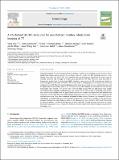A 16-channel AC/DC array coil for anesthetized monkey whole-brain imaging at 7T
Author(s)
Gao, Yang; Mareyam, Azma; Sun, Yi; Witzel, Thomas; Arango, Nicolas; Kuang, Irene; White, Jacob; Roe, Anna Wang; Wald, Lawrence; Stockmann, Jason; Zhang, Xiaotong; ... Show more Show less
DownloadPublished version (3.438Mb)
Publisher with Creative Commons License
Publisher with Creative Commons License
Creative Commons Attribution
Terms of use
Metadata
Show full item recordAbstract
© 2019 Functional magnetic resonance imaging (fMRI) in monkeys is important for bridging the gap between invasive animal brain studies and non-invasive human brain studies. To resolve the finer functional structure of the monkey brain, ultra-high-field (UHF) MR is essential, and high-performance, close-fitting RF receive coils are typically desired to fully leverage the intrinsic gains provided by UHF MRI. Moreover, static field (B0) inhomogeneity arising from the tissue susceptibility interface is more severe at UHF, presenting an obstacle to achieving high-resolution fMRI. B0 shim of the monkey head is challenging due to its smaller size and more complex sources of B0 offsets in multi-modal imaging tasks. In the present work, we have customized an array coil for lightly-anesthetized monkey fMRI in the 7T human scanner that combines RF and multi-coil (MC) B0 shim functionality (also referred to as AC/DC coils) to provide high imaging SNR and high-spatial-order, rapidly switchable B0-shim capability. Additional space was retained on the coil to render it compatible with monkey multi-modal imaging studies. Both MC global (whole-volume) and dynamic (slice-optimized) shim methods were tested and evaluated, and the benefits of MC shim for fMRI experiments was also studied. A minor reduction in RF coil performance was found after introducing additional B0 shim circuitry. However, the proposed RF coil provided higher image SNR and more uniform contrast compared to a commercially available coil for human knee imaging. Compared with static 2nd-order shim, the B0 inhomogeneity was reduced by 56.8%, and 95-percentile B0 offset was reduced to within 28.2 Hz through MC shim, versus 68.7 Hz with 2nd-order static shim. As a result, functional image quality could be improved, and brain activation can be better detected using the proposed AC/DC monkey coil.
Date issued
2020Department
Massachusetts Institute of Technology. Department of Electrical Engineering and Computer ScienceJournal
NeuroImage
Publisher
Elsevier BV